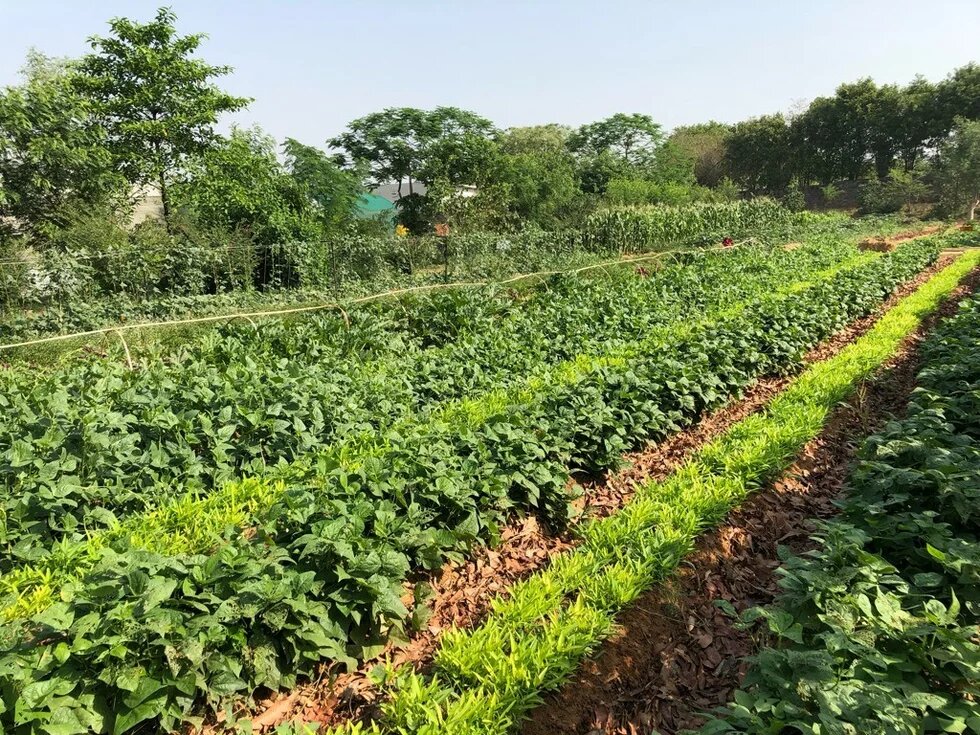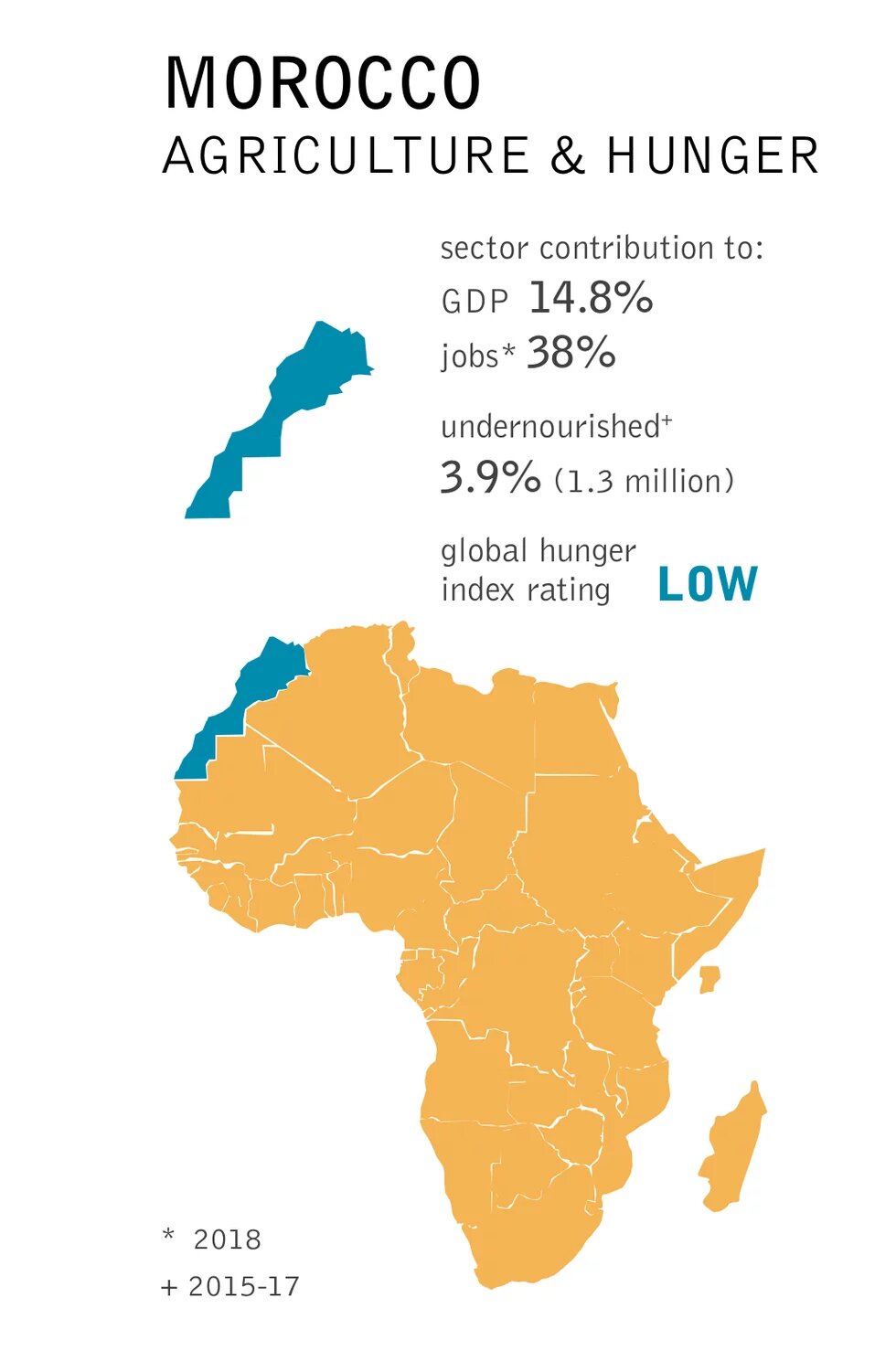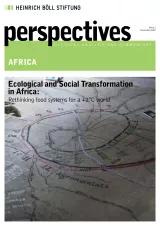
Like most countries of the global South, Morocco is disproportionately affected by the climate crisis relative to how much it contributed to creating it. Although Morocco contributes only 0.18 percent[1] to global greenhouse-gas emissions each year, current predictions of its future feature increased temperature, decreased rain regularity, sea-level rise and a feedback effect on both forest-cover and fish populations. With somewhat ambitious renewable-energy production targets and other policies to reduce the carbon footprint of the economy, Morocco presents itself as an environmental leader in Africa. However, these are all climate-mitigation actions; it budgets considerably less for climate-adaptation projects[2]. In this essay, I argue that Morocco, on the forefront of emissions reductions in Africa, should be more concerned about the adaptation of its agriculture sector, a main pillar of its economy. Moreover, within the framework of sustainable development, doing so could be a great vector for development, considering the sheer number of people who derive a living from agriculture and would otherwise be on the brink of poverty and food insecurity.

Defined simply, “climate mitigation” is any action that aims to reduce greenhouse gas emissions and “climate adaptation” is any action whose purpose is to adapt to already existing or expected climate conditions. In the case of agricultural production, climate-mitigation efforts would try to minimise transport and the resulting emissions by employing local workers, minimising inputs that have to be brought in from elsewhere, and selling locally. Another mitigation strategy would be to reduce reliance on greenhouse-gas-intensive industrial products, such as nitrogen-based fertiliser. Measures for climate adaptation in agriculture could work towards drought-proofing crops by curtailing the use of water and reducing evaporation rates; making use of different varietals to minimise crop losses due to changing pest and disease patterns; and increasing soil fertility to compensate for predicted depletion. Adaptation techniques generally deliver in the long term and require some upfront costs.
It might already be clear that, due to financial instruments such as carbon taxes or emissions trading schemes, mitigation might be more profitable than adaptation in the short term, while adaptation will only deliver in a decade or so when the effects of the climate crisis are fully felt and recognised. This might be why many developing countries are prioritising mitigation over adaptation, with some perhaps thinking that mitigation now might finance adaptation later. Let us not forget, however, that “short-termism” is partly, if not wholly, responsible for creating the climate crisis in the first place. Apart from the fact that most developing countries cannot afford to do mitigation and adaptation at the same time, I still argue that prioritising mitigation is problematic for them. Not least because mitigation supports better-off actors in the industrial sector while long-term investment in adaptation will also help the poor by providing future food and financial security.
Agriculture’s Coming Suffering
The climate crisis will certainly hit diverse sectors of Morocco’s economy, but it is particularly important to highlight the agricultural sector, as this will suffer badly under even the most optimistic climate-change scenario. Agriculture contributes 14.8 percent of Morocco’s GDP and employs 38% percent of the workforce[3]. The sector is not only affected indirectly by increasing input prices but also directly by changing weather patterns. Irregular rainfall is of particular concern, as many vegetable crops need reasonably predictable rain to determine ploughing and planting schedules accordingly and not lose soil fertility or seeds to birds and insects. Longer heatwaves, which are also on the agenda of the climate crisis, can burn the flowers of fruiting trees. A heatwave prolonged by only one or two days can have devastating effects on Morocco’s olive trees. Higher temperatures might be generally perceived as good in some mountainous regions, but they also lead to increased agricultural demand for water in an already water-stressed country.
The overall ecosystem will also respond to the climate crisis, with indications of a potential increase in locust infestations due to the redistribution of insect populations. The possibility of pollinators dying out has alone been quantified at a cost of US$200 billion worldwide[4]. The climate crisis is also intertwined with social concerns. Affordable food will no longer be affordable to workers in Morocco’s agricultural sector if they suddenly fall below the poverty line or lose their jobs. Smallholder farmers, who constitute the bulk of the sector’s workforce, will be more adversely affected than farmers who can afford a few dips in their profit margins.
Many people in the various ministries and organisations concerned are thinking about solutions and some are already being implemented. Unfortunately, they are generally piecemeal, picking up one issue and disregarding others. For example, the International Centre for Agricultural Research in the Dry Areas (ICARDA) in Rabat studies alternative pollinators to see whether the bumblebee, grasshopper or even the butterfly could respond to the pessimistic scenario of major honeybee die-off[5]. Such an initiative is laudable, but it does not take into consideration the intricate nature of entomology: most insects rely on each other to survive, and the insect food-web might not persist in the absence of such a major actor as the honeybee. The introduction of new insect populations could also constitute an invasive species in a particularly fragile region. Tech-fixes like this would benefit from a holistic perspective in which each particular solution is part of a system of solutions, all working towards a common goal. A surgical intervention or replacement created from an engineering mindset does not succeed when nature proves not to function like a machine.
Adaptation Techniques
So, if adaptation is a priority and it demands to be done in a holistic manner, what would a win-win scenario look like? It could be one in which adaptation techniques deliver short-term gain as well as long-term protection, cost very little upfront and do not demand a huge technology transfer. A series of water-saving techniques derived from agroecology might provide just that.
Agroecology is a science that applies insights from ecological processes to agriculture. For example, drought-proofing through the application of compost made of agricultural residues to increase water retention (turning soil into a sponge, basically), the use of mulching to reduce evaporation, plus low-tech remedies such as drip irrigation, which is already available in much of the country, could alone save up a large amount of water[6]. Multistorey tree planting can also create shade for shade-loving crops to flourish without too much water, as they are protected from evaporation and benefit from the trees’ transpiration. The oasis model – although in decline in Morocco and mostly small-scale – has a lot of insight to deliver. Palm trees provide an overstorey that shades fruiting trees, which in turn provide shade to crops growing under them, namely bushes, tubers and shoots such as alfalfa, which is a prime fodder crop in Morocco. The difference in the trees’ height also reduces competition for water as it occurs at different depths in the soil. Bigger oases can be created by replicating the same model, irrigating with drip irrigation, turning all the residue and cattle manure into compost and applying it, and mulching on top of it with all the dried leaves from the over-storey trees. Such a system would provide short-term gain in water costs, provide long-term protection from heat and hydraulic stresses due to a humid microclimate, costs very little in infrastructure, and would only demand basic technologies such as drip irrigation and, ideally, a chipper to facilitate the shredding of agricultural waste for compost, which could also be shared by farmers from the same village.
Such a radical departure from a conveyor-belt type of efficiency would require more complexity in its management and, in most cases, more human labour than machine labour. Rather than one big tractor working the field, there might be twenty farmers doing different jobs, from flipping compost to mulching trees. This working strategy would lead to the establishment of stronger farmer unions and cooperatives to advocate for greater control over conditions and decision-making regarding farm work, for different systems of profit-sharing than the risky daily employment schemes used conventionally today in Morocco, and generally for a worker-centric rather than produce-centric approach to subsidies in the agricultural sector. On a farm level, such as a system might look like the image below of a project in India, which was implemented by Moroccan consultant Mohammed Erribani in collaboration with The Hans Foundation.
Another win-win strategy might be termed “adaptation through fertility management”. Instead of opting for risky genetically modified organism (GMO) varieties, which are designed to be drought-resistant but whose impacts on the ecosystem are untested, a mix of diverse varieties will provide genetic resilience in the face of disease and climate stress.
As different subspecies perform differently under the same conditions, artificial selection and seed-saving of the best performing plants will yield resistant varieties while, at the same time, saving the cost of buying hybrid seeds or expensive copyright-bearing GMO seeds every year. In addition, succession management through the use of summer cover crops such as maize or clover during the hottest months can help protect the soil from losing its fertility.
Inoculating the soil with compost and irrigating with compost tea (a fermented brew of compost soaked in aerated water overnight) can multiply the number of micro-organisms present in the soil, which in turn leads to better aeration, decomposition of the mulch, and ultimately increased fertility through the creation of a layer of humus every year. As the layer’s thickness increases with each passing year, along with the water-retention capacity of the soil, the land becomes cheaper and cheaper to manage for fertility. This strategy can indeed provide a short-term gain in terms of added fertility, resistance to disease, and reduced seed costs as it safeguards the future of the farm against fertility loss due to the climate crisis, and leads ultimately to a better-suited environment for agriculture under harsher conditions.
While this all might seem very logical, it cannot be denied that many agricultural service providers (and thus economic actors) will be made irrelevant. Economic losses would be felt by the big agricultural conglomerates that sell fertiliser and pesticide, such as Syngenta, Dow Chemical and Bayer-Monsanto, and those selling the equipment required for large-scale agriculture. Knowing that some of these actors may constitute a powerful lobbying force in politics, there is need for a sustainable-agriculture lobby to counter potential resistance to change.
Both of the climate-adaptation strategies mentioned here also provide a sizable contribution to climate mitigation by increased carbon-sequestration (carbon capture) in the soil[7]. In fact, the adaptation of agriculture through agroecology could very well deliver mitigation benefits down the line – although it may be argued that it would come too late.
A better adaptation strategy for mitigation purposes would be to train farmers and professional agriculturalists in agroecology and in-house water-saving and fertility management. Doing so might reduce the need for industrial nitrogen fertiliser and expensive seed imports, both of which are energy- and greenhouse-gas-intensive industries. Developing agriculture that is centred on small-farm production through knowledge transfers in a decentralised fashion will surely provide Morocco with a blueprint to emit less greenhouse gas without cutting corners in its economy, and to alleviate the risk of a big increase in poverty. The ideal scenario would be to develop a Moroccan sustainable-development strategy that is radically different from what is conceived as sustainable development in other contexts, or simply reducing greenhouse gas emissions.
The new strategy, which will involve less high technology and make innovative use of low technology, would replace the current agricultural model that requires massive subsidies and keeps the wealth concentrated in the hands of a few. To maintain their business role, big agricultural companies can transform their operations towards “transitional agriculture”, helping farms to set up new agroecological systems and selling them low-tech equipment such as chippers, composters, compost-tea brewers, and even hand-powered mini-tractors. The economic opportunity then switches from the ever-increasing drive for more efficient use of big machinery to the development of a supply chain of sustainability, such as providing local labour and local materials for the manufacture of equipment, decentralising operations, developing region-specific innovations in low-tech machinery, seeds and techniques, and creating new farmer-worker economic schemes.
Conclusion
To conclude, climate adaptation is a necessary priority for Morocco to avoid many risks. Morocco’s economy and population are both exposed to the climate crisis, and the country’s budget and administrative resources remain hard-pressed to engage in both adaptation and important mitigation actions. For example, renewable energies are only expected to provide 52% of Morocco’s installed capacity of energy production by 2030, which is a tiny figure as the country currently imports almost all of its energy needs in the form of coal (31%), hydroelectricity (22%), fuel oil (25%), and natural gas (10%)[8].
For a developing country like Morocco, sustainable development entails staying within the carrying capacity of the environment as well as improving human development. A focus on adaptation serves both goals, particularly through holistic agroecological strategies in the agriculture sector that can deliver short-term gain, long-term protection and poverty alleviation through the provision of income and food security. It surely represents a win-win approach as it also mitigates the climate crisis by reducing dependency on the carbon-emitting industries that constitute the backbone of today’s agriculture. Nevertheless, the necessary economic restructuring will demand strong political will and lobbying from organised civil society.
[1] Calculations using data available at Climate Action Tracker: https://climateactiontracker.org/countries/morocco/
[2] Houzir, M., and Alaoui, Z. 2018. Transparence dans la Finance Climat au Maroc [Transparency in Morocco's Climate Finance]. Heinrich Böll Stiftung Rabat. Available at: https://ma.boell.org/sites/default/files/transparence_dans_la_finance_c…
[3] Data from the World Factbook 2018. https://www.cia.gov/library/publications/the-world-factbook/geos/print_ mo.html and International Labour Organization, ILOSTAT database. Data retrieved in September 2019 from https://data.worldbank.org/indicator/sl.agr.empl.zs?view=map
[4] Helmholtz Association of German Research Centres. 2008. Economic Value of Insect Pollination Worldwide Estimated at US$217 Billion. Available at: https://www.sciencedaily.com/releases/2008/09/080915122725.htm
[5] ICARDA. 2015. Farming with Alternative Pollinators. Available at: https://www.icarda.org/annual-report-2015/01-farming-with-alternative-p…
[6] Ranjan, P. et al. 2017. Organic Mulching: A Water Saving Technique to Increase the Production of Fruits and Vegetables. Available at: http://www.agriculturejournal.org/volume5number3/organic-mulching-a-wat…
[7] Ranjan, P. et al. 2017. Organic Mulching: A Water Saving Technique to Increase the Production of Fruits and Vegetables. Available at: http://www.agriculturejournal.org/volume5number3/organic-mulching-a-wat…
[8] US International Trade Administration. Morocco – Energy. Last published 15 July 2019. https://www.export.gov/article?id=Morocco-Energy



